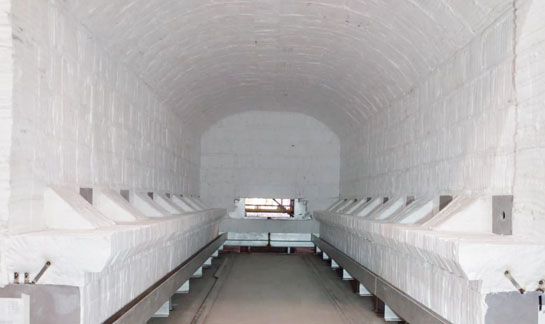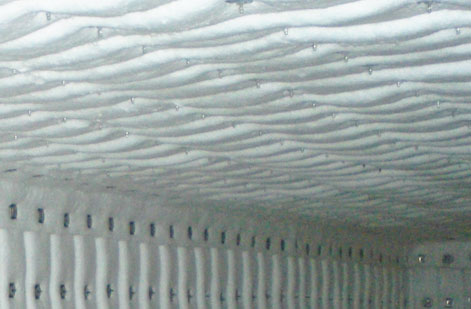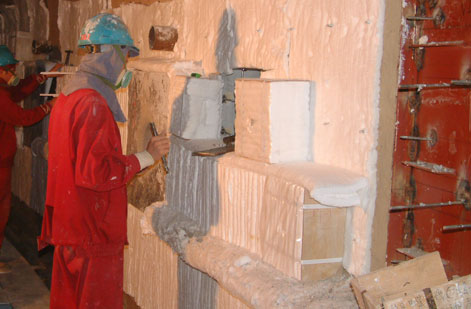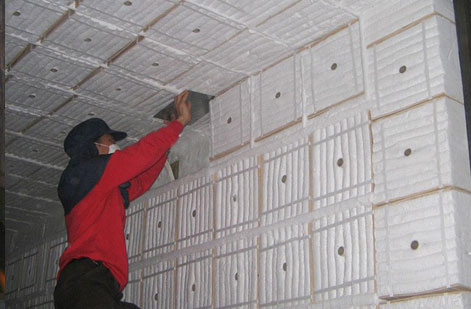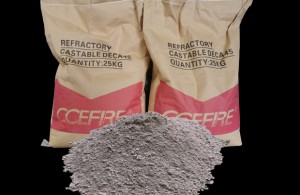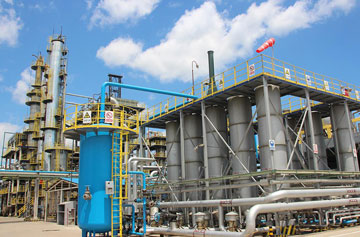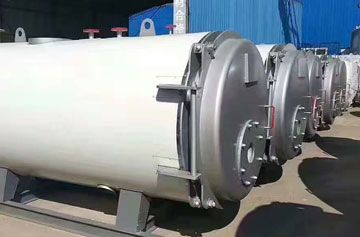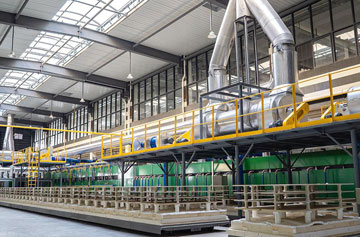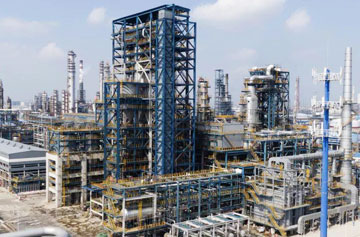Design and construction of trolley furnaces
Overview:
The trolley furnace is a gap-type varied-temperature furnace, which is mainly used for heating before forging or heat treating on workpieces. The furnace has two types: a trolley heating furnace and a trolley heat treatment furnace. The furnace consists of three parts: a movable trolley mechanism (with refractory bricks on the heat-resistant steel plate), a hearth (fiber lining), and a liftable furnace door (multi-purpose castable lining). The main difference between the trolley-type heating furnace and the trolley-type heat treatment furnace is the furnace temperature: the temperature of the heating furnace is 1250~1300℃ while that of the heat treatment furnace is 650~1150℃.
Determining lining materials:
In consideration of various factors, such as furnace’s internal temperatures, furnace’s internal gas atmosphere, safety, economy and many years of practical experience, the heating furnace lining materials are generally determined as: the heating furnace top and furnace walls mostly use CCEWOOL zirconium-containing fiber prefabricated components, the insulation layer uses CCEWOOL high-purity or high-aluminum ceramic fiber blankets, and the furnace door and below use CCEWOOL fiber castable.
Determining insulation thickness:
The trolley furnace adopts a new type of full-fiber lining which significantly enhances heat insulation, heat preservation and energy saving of the furnace. The key to the design of the furnace lining is a reasonable insulation thickness, which mainly depends on the temperature requirements of the outer wall of the furnace. The minimum insulation thickness is determined through thermal calculations, for the purposes of achieving better energy-saving effects and reducing the weight of the furnace structure and the investment costs in equipment.
Lining structure:
According to the process conditions, the trolley furnace can be divided into a heating furnace and a heat treatment furnace, so there are two types of structure.
The heating furnace structure:
According to the shape and structure of the heating furnace, the furnace door and the bottom of the furnace door should adopt CCEWOOL fiber castable, and the rest of the furnace walls can be laid with two layers of CCEWOOL ceramic fiber blankets, and then stacked with the fiber components of herringbone or angle iron anchoring structure.
The top of the furnace is tiled with two layers of CCEWOOL ceramic fiber blankets, and then stacked with the fiber components in the form of a single-hole hanging and anchoring structure.
As the furnace door often rises and falls and materials often collide here, the furnace door and the parts below the furnace door mostly use CCEWOOL fiber castable, which has a structure of unshaped fiber castable and the inside welded with stainless steel anchors as the skeleton.
The heat treatment furnace structure:
Considering the shape and structure of the heat treatment furnace, the furnace door and the bottom of the furnace door should be made of CCEWOOL fiber castable, and the rest of the furnace walls can be tiled with two layers of CCEWOOL ceramic fiber blankets, and then stacked with the fiber components of a herringbone or angle iron anchor structure.
The top of the furnace is tiled with two layers of CCEWOOL ceramic fiber and then stacked with the fiber components in the form of a single-hole hanging anchor structure.
As the furnace door often rises and falls and materials often collide here, the furnace door and the parts below the furnace door often use CCEWOOL fiber castable, which has the structure of unshaped fiber castable and the inside welded with stainless steel anchors as the skeleton.
For the lining structure on these two types of furnace, the fiber components are relatively firm in installation and fixing. The ceramic fiber lining has good integrity, a reasonable structure, and remarkable thermal insulation. The whole construction is quick, and the disassembly and assembly are convenient during maintenance.
The fixed form of ceramic fiber lining installation arrangement:
Tiled ceramic fiber lining: generally, tile ceramic fiber blankets for 2 to 3 layers, and leave 100 mm of the staggered seam distance between layers as required instead of straight seams. The ceramic fiber blankets are fixed with stainless steel bolts and quick cards.
Ceramic fiber components: According to the characteristics of the anchoring structure of the ceramic fiber components, they are all arranged in the same direction along the folding direction. The ceramic fiber blankets of the same material are folded into a U shape between different rows to compensate for ceramic fiber shrinkage. The ceramic fiber components at the furnace walls adopt "herringbone" shaped or "angle iron" anchors, fixed by screws.
For the central hole hoisting fiber components on the furnace top of the cylindrical furnace, a "parquet floor" arrangement is adopted, and the fiber components are fixed by welding bolts at the furnace top.
Post time: Apr-30-2021


